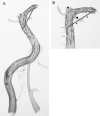In vitro studies of the neuroform microstent using transparent human intracranial arteries
- PMID: 16687559
- PMCID: PMC7975717
In vitro studies of the neuroform microstent using transparent human intracranial arteries
Abstract
For better understanding of relevant morphology and mechanics, direct visualization of a Neuroform microstent (NFM) within an actual human intracranial artery is essential. Twelve NFM were deployed into 8 various segments of formaldehyde-fixed cadaver intracranial arteries. The arteries were then dehydrated and cleared in methyl salicylate to create transparency. The morphology of NFM was studied by digital macro-photography with a back illumination system. The possible limitations and important findings of the NFM were discussed.
Figures








Similar articles
-
Colour flow imaging of the great intracranial arteries in infants.Neuroradiology. 1989;31(1):40-3. doi: 10.1007/BF00342028. Neuroradiology. 1989. PMID: 2654694
-
[Structural variations in the arteries of the base of the brain].Vopr Neirokhir. 1974 Sep-Oct;(5):23-9. Vopr Neirokhir. 1974. PMID: 4425023 Russian. No abstract available.
-
Anatomy of the cerebral vasculature.Neuroimaging Clin N Am. 1994 Nov;4(4):691-706. Neuroimaging Clin N Am. 1994. PMID: 7858916 Review.
-
[Functional anatomy of the cerebral arteries].No Shinkei Geka. 2005 Mar;33(3):213-24. No Shinkei Geka. 2005. PMID: 15773310 Review. Japanese. No abstract available.
-
Vascularization of the brain in guinea pig. I. Gross anatomy of the arteries and veins.Folia Morphol (Warsz). 1994;53(4):249-68. Folia Morphol (Warsz). 1994. PMID: 7622137
Cited by
-
Construction of an in vivo carotid siphon model for testing endovascular devices for neuro-interventions.Interv Neuroradiol. 2017 Jun;23(3):325-329. doi: 10.1177/1591019916688649. Epub 2017 Feb 2. Interv Neuroradiol. 2017. PMID: 28152631 Free PMC article.
-
Influence of different computational approaches for stent deployment on cerebral aneurysm haemodynamics.Interface Focus. 2011 Jun 6;1(3):338-48. doi: 10.1098/rsfs.2011.0004. Epub 2011 Mar 23. Interface Focus. 2011. PMID: 22670204 Free PMC article.
-
Endovascular occlusion of intracranial wide-necked aneurysms with stenting (Neuroform) and coiling: mid-term and long-term results.Neuroradiology. 2009 Jun;51(6):401-9. doi: 10.1007/s00234-009-0502-2. Epub 2009 Feb 25. Neuroradiology. 2009. PMID: 19241069
-
Y-stenting endovascular treatment for ruptured intracranial aneurysms : a single-institution experience in Korea.J Korean Neurosurg Soc. 2012 Sep;52(3):187-92. doi: 10.3340/jkns.2012.52.3.187. Epub 2012 Sep 30. J Korean Neurosurg Soc. 2012. PMID: 23115659 Free PMC article.
-
Stent-assisted embolization of wide-neck anterior communicating artery aneurysms: review of 21 consecutive cases.AJNR Am J Neuroradiol. 2009 Sep;30(8):1502-6. doi: 10.3174/ajnr.A1618. Epub 2009 May 20. AJNR Am J Neuroradiol. 2009. PMID: 19461055 Free PMC article.
References
-
- Howington JU, Hanel RA, Harrigan MR, et al. The Neuroform stent, the first microcatheter-delivered stent for use in the intracranial circulation. Neurosurgery 2004;54:2–5 - PubMed
-
- Karino T, Motomiya M. Flow visualization in isolated transparent natural blood vessels. Biorheology 1983;20:119–27 - PubMed
-
- Lylyk P, Cohen JE, Ceratto R, et al. Endovascular reconstruction of intracranial arteries by stent placement and combined techniques. J Neurosurg 2002;97:1306–13 - PubMed
Publication types
MeSH terms
LinkOut - more resources
Full Text Sources
Other Literature Sources
